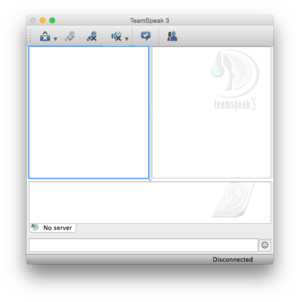TeamSpeak
 | |
|
TeamSpeak 3 client running on OS X Yosemite | |
| Original author(s) | TeamSpeak Systems GmbH |
|---|---|
| Initial release | October 2001 |
| Stable release |
3.0.19.4 (Client) / 3.0.13.4 (Server)
/ April 6, 2016 (Client) / August 4, 2016 (Server) |
| Operating system | Microsoft Windows, Linux, OS X, iOS, FreeBSD (Server Only), Android |
| Type | VoIP Software |
| License | Proprietary, freeware |
| Website |
www |
TeamSpeak is proprietary voice-over-Internet Protocol (VoIP) software for audio communication between users on a chat channel, much like a telephone conference call. Users typically use headphones with a microphone. The client software connects to a TeamSpeak server of the user's choice, from which the user may join chat channels.
The target audience for TeamSpeak is gamers, who can use the software to communicate with other players on the same team of a multiplayer game. Communicating by voice gives a competitive advantage by enabling players to keep their hands on the controls.[1]
Server
The TeamSpeak server runs as a dedicated server on Microsoft Windows, Mac OS X, Linux and FreeBSD and uses a web based user interface or a command-line interface to control server administration and configuration. TeamSpeak clients are available for Windows, Mac OS X, Linux, iOS, and Android.
The TeamSpeak 3 server can be used at no cost for up to 32 slots (simultaneous users). For non-commercial use, non-profit licenses are available that allow to use the server with up to 512 slots (users) at a time. With the use of 512 slots server admins can choose to split up the slots into multiple virtual server instances (up to 2).[2]
TeamSpeak 2 supports virtual server instancing. This allows up to 75 server instances to be contained in one process on the server. Additional server processes are possible.[3]
Port 9987 is the default UDP port for TeamSpeak 3.[4]
TeamSpeak 3
The current version of TeamSpeak[5] has been in development since 2004. It is a complete rewrite with many new features, but has had infrequent updates on the development blog, and was first estimated to be released in mid-2006. The first public release of the TeamSpeak 3 SDK[6] was on June 5, 2008, with the integrated solution in the MMO game Vendetta Online.[7] Open beta of TeamSpeak 3 was released on December 9, 2009.[8] Open beta was closed on August 10, 2011 and replaced with Teamspeak 3.0.0 Final, which is the first stable release of Teamspeak 3.[9]
TeamSpeak 3 introduced the use of unique IDs, maintained in the program as identities, that are randomly generated at the time of a client's initial setup. An identity contains a nickname, which can be changed at any time, the Unique ID and an identity name, which is not visible to other users on the server. The unique id is used by the server to grant permissions to the user. Unique IDs replaced the need for a user to register with the server to keep their user group, be it a channel group or a server group.
Permissions system
When TeamSpeak 3 was first introduced in the Open Beta release, the server administrators were confronted with a major change in granting administrative powers to users, in the way of a permissions system based on boolean and integer, which permitted better user control.
The permissions system has two types of integer-based permissions: Power and Needed Power. The Power is the power level in numbers that the group/user has for that permission. The Needed Power is the power level in numbers needed by the group/user to use that specific permission. If the Power level is lower than the Needed Power level then the permission cannot be used. If the Power level is equal to or higher than the Needed Power level then the group/user will be able to use it.
TeamSpeak 3 also has a 5-tier hierarchy within its permissions system: Server Group, Client Permissions, Channel Permissions, Channel Groups and Channel Client Permissions. The five are used to override another type, also known as inheriting. This allows for highly complex permissions for users, giving users more powers and uses in TeamSpeak without giving away complete control to the users of the server.
With the release of later versions the TeamSpeak developers created easier ways to set up permissions in the way of a "Standard Permissions Display" by default in the client. This placed the original permissions system display behind the "Standard" one calling it "Advanced Permissions Display". This allowed beginners more ease of use when setting up a TeamSpeak 3 server. Some still prefer the Advanced system because it allows more control over which permissions get changed, whereas the Standard changes many permissions at the same time.
TeamSpeak3 updates
TeamSpeak 3 uses an improved update system that updates only the files necessary, resulting in faster updates without the need to redownload the entire program. TeamSpeak3 has recently added many new features such as a microphone "Overclock" system that allows users to amplify microphone quality.
In popular culture
TeamSpeak was mentioned numerous times within South Park's episode titled "Make Love, Not Warcraft" which aired October 4, 2006 on Comedy Central.[10]
See also
References
- ↑ Bary, Hiawatha (October 29, 2003). "Game On; Players Add Verbal Jabs To Online Arsenal". The Boston Globe.
- ↑ "Licensing". sales.teamspeakusa.com. Teamspeak.
- ↑ Running Multiple TeamSpeak 2 Instances
- ↑ "Which ports does the TeamSpeak 3 server use?". TeamSpeak 3 Technical Support.
- ↑ "TeamSpeak 3". TeamSpeak Systems GmbH. Retrieved 2008-07-14.
- ↑ "Guild Software and TeamSpeak announce the Integration of TeamSpeak 3 within Vendetta Online" (Press release). Florence Espinoza. 2008-07-01. Retrieved 2008-07-14.
- ↑ "Now featuring.. Voice Chat!". Guild Software. 2008-06-05. Retrieved 2008-07-14.
- ↑ News. TeamSpeak. Retrieved on 2014-05-22.
- ↑ TeamSpeak 3 Final + iOS + Android Released. Forum.teamspeak.com. Retrieved on 2014-05-22.
- ↑ News. TeamSpeak (2006-10-11). Retrieved on 2014-05-22.
